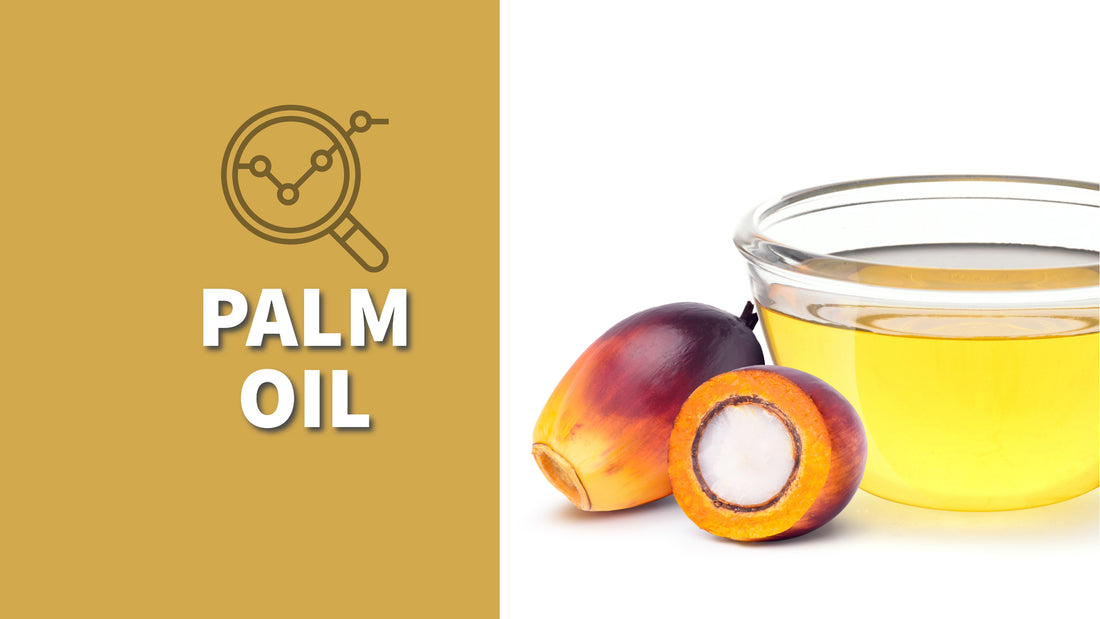
Palm Oil Guide
Palm oil is a versatile and widely used vegetable oil, extracted from the fruit of the oil palm tree (Elaeis guineensis). Native to West Africa, these trees thrive in tropical regions and are now cultivated extensively in Southeast Asia, Latin America, and other warm climates. Palm oil is unique due to its balanced composition of saturated and unsaturated fatty acids, making it semi-solid at room temperature and highly stable, which contributes to its popularity in various industries.
Production Process
The process of obtaining palm oil involves several steps:
- Harvesting: The oil palm fruit bunches are harvested from the trees. Each bunch contains numerous individual fruits.
- Sterilization: The harvested bunches are sterilized using steam. This process stops enzymatic spoilage and loosens the fruits from the bunches.
- Threshing: The fruits are separated from the bunches in a mechanical process called threshing.
- Digestion and Pressing: The separated fruits are then digested and pressed to extract crude palm oil from the pulp.
- Clarification and Purification: The crude oil undergoes clarification to remove impurities and water. The oil is then purified to achieve the desired quality.
- Refining: Finally, the oil is refined to remove any remaining impurities, resulting in the palm oil that is commonly used in various products.
Applications
Cooking and Food Production: Palm oil is commonly used in cooking, especially for frying, due to its high smoke point. It's also a key ingredient in many processed foods, including margarine, ice cream, chocolate, cookies, and instant noodles, due to its ability to enhance texture and shelf life.
Baking: In baking, palm oil is used as a butter substitute. It provides a creamy texture and helps in maintaining the moisture of baked goods.
Non-Dairy Creamers and Margarine: Palm oil is often used in non-dairy creamers and margarine because of its creamy texture and ability to remain solid at room temperature.
Personal Care and Cosmetics: In the cosmetics industry, palm oil is used in products like soaps, shampoos, lotions, and makeup. It acts as a moisturizing agent and is also used for its emulsifying properties.
Pharmaceuticals: Palm oil derivatives are used in the manufacture of certain medications, serving as excipients or carriers.
Industrial Uses: Palm oil is used in the production of biofuels, particularly as a feedstock for biodiesel. It's also used in lubricants, greases, and other industrial applications.
Animal Feed: Palm oil is sometimes included in animal feed, particularly for pets and livestock, due to its energy content and fat-soluble vitamins.
Confectionery Fats: In the confectionery industry, palm oil is used to create certain types of specialty fats, which are key ingredients in many candies and chocolate products.
Nutritional Products: Due to its nutritional profile, palm oil is used in certain fortified foods and nutritional supplements.
Household Products: Palm oil is found in some household cleaning products and detergents, contributing to their effectiveness and consistency.
Nutrition
Palm oil is high in calories and fats. Its nutritional profile includes:
Fatty Acids: It contains a balanced mix of saturated and unsaturated fatty acids, including palmitic acid, oleic acid, and linoleic acid.- Saturated Fats: Approximately 50%. The main saturated fat in palm oil is palmitic acid, which constitutes about 44% of the oil. Other saturated fats include stearic acid and myristic acid.
- Monounsaturated Fats: Around 40%. The primary monounsaturated fat in palm oil is oleic acid.
- Polyunsaturated Fats: About 10%. Linoleic acid is the main polyunsaturated fat found in palm oil.
Vitamin E: Palm oil is a good source of tocopherols and tocotrienols, forms of vitamin E that act as antioxidants.
Beta-Carotene: Red palm oil is rich in beta-carotene, a precursor of vitamin A.
No Trans Fats: Naturally, palm oil does not contain trans fats, although some of them may be hydrogenated to create them.
Types
Crude Palm Oil (CPO): Extracted from the fruit's pulp, it's unrefined and used in industrial applications.
Refined Palm Oil: Purified and bleached, it's used in cooking and food manufacturing.
Red Palm Oil: Less processed, retains more nutrients like beta-carotene, giving it a characteristic red color.
Palm Kernel Oil: Extracted from the seed or kernel, it has different properties and uses compared to oil from the fruit's pulp.
Fractionated Palm Oil: Divided into liquid (olein) and solid (stearin) components, used in various food and non-food products.
Palm oil shortening: This is a semi-solid fat created from palm oil that has been fractionated and processed to change its melting point. Shortening is designed to be solid at room temperature and is used in baking and cooking to create a short (crumbly or flaky) texture in products like pastries and pie crusts.
Health Benefits
Palm oil, particularly red palm oil, offers several health benefits due to its unique nutritional composition. Here are some of the key health benefits associated with palm oil:
- Rich in Vitamin E: Palm oil is a good source of tocotrienols, a form of vitamin E that has powerful antioxidant properties. Antioxidants help protect the body from damage caused by free radicals, potentially reducing the risk of certain chronic diseases.
- Contains Beta-Carotene: Red palm oil is high in beta-carotene, a precursor to vitamin A. This nutrient is essential for good vision, skin health, and immune function.
- Heart Health: Some studies suggest that the balanced ratio of unsaturated and saturated fats in palm oil can have a neutral effect on cholesterol levels, potentially supporting heart health. However, this is subject to the overall dietary context and individual health conditions.
- Brain Health: The tocotrienols in palm oil may also benefit brain health. Research indicates that they may have neuroprotective properties, helping to preserve brain tissue and potentially reduce the risk of stroke and dementia.
- Energy Source: Palm oil is calorie-dense and can be a good source of energy, which is particularly beneficial in diets where energy intake is a concern.
- Stable Cooking Oil: Due to its high oxidative stability, palm oil doesn't break down or oxidize easily at high temperatures, making it a healthier choice for cooking compared to oils that form harmful compounds when heated.
- Supports Vitamin Absorption: Being a fat, palm oil aids in the absorption of fat-soluble vitamins (A, D, E, and K) from other foods consumed as part of a meal.
It's important to note that while palm oil has these potential health benefits, its impact can vary based on individual dietary patterns, the type of palm oil consumed (refined vs. unrefined), and overall lifestyle. As with any dietary fat, moderation is key, and it's best to consume palm oil as part of a balanced diet. Additionally, the environmental impact of palm oil production, particularly concerning deforestation and biodiversity loss, has led to calls for sustainable production practices.
Palm Oil We Use
The palm oil we use is not only free of trans fats but our suppliers are comitted to the "No Deforestation, No Peat, and No Exploitation (NDPE)" policy, which means they work hard to ensure that their supply chain is transparent and protects forests around the globe. This means:
No Deforestation: Our supplier promises not to destroy primary forests or other areas rich in carbon (think of these areas as the lungs of our planet). Instead, they focus on developing land that has already been cleared or used for agriculture.
No Development in High Conservation Value Areas: Our supplier is dedicated to preserving land that has special environmental, social, or cultural importance. This means they won't touch areas that are critical for the survival of unique ecosystems or the well-being of local communities.
No Burning: Our supplier sticks to a strict no-burn policy, meaning they never use fire to clear land for palm production. This helps to protect the environment from harmful air pollution and habitat destruction.
No-Peat: Our supplier refuses to develop peatlands, which are unique wetlands that store massive amounts of carbon. By leaving these areas untouched, they're helping to combat climate change.
No Exploitation: Last but not least, our supplier ensures that people and local communities are treated fairly and with respect. They follow international labor standards, respect land rights, and support the inclusion of small farmers in their supply chain.
Home Use
Palm oil is a versatile cooking oil that can be used in various ways at home:
- Frying: Due to its high smoke point, it's excellent for deep-frying and sautéing.
- Baking: Substitute for butter or other oils in recipes for a unique flavor and texture.
- Spreading: Red palm oil can be used as a spread on bread or crackers.
- Flavoring: Adds a distinct flavor to dishes like curries, soups, and stews.
- Preserving: Its oxidative stability helps in preserving homemade sauces and condiments.
FAQ
Is palm oil safe to consume?
Yes, palm oil is safe for consumption when used as part of a balanced diet. It's widely used in food products worldwide.
What is the difference between food grade versus other types of palm oil?
Food-grade palm oil is processed and refined for consumption, meeting safety standards for food products. Non-food-grade palm oil may be used in industrial applications and is not suitable for consumption.
How is palm oil digested in our bodies?
Palm oil is digested like other dietary fats. It's broken down by enzymes in the digestive system into fatty acids and glycerol, which are then absorbed and metabolized by the body.
Why is palm oil added to food products?
Palm oil is added for its stability, texture, and shelf-life extending properties. It also contributes to the mouthfeel and flavor of food products.
Does palm oil have a taste or aroma?
Refined palm oil has a neutral taste and aroma, making it versatile for cooking. Unrefined or red palm oil has a distinct, slightly nutty flavor and aroma.
What is the smoke point of palm oil?
Palm oil has a high smoke point of about 230°C (446°F), making it suitable for high-temperature cooking.
What is the melting point of palm oil?
The melting point of palm oil varies between 24°C to 39°C (75°F to 102°F), depending on its composition and processing.
Is palm oil natural or organic?
Palm oil is a natural oil extracted from the fruit of the oil palm tree. It can be organic if produced following organic farming standards.
Is palm oil shelf-stable?
Yes, palm oil is highly shelf-stable due to its high saturated fat content and natural antioxidants, which prevent rancidity.
How do you store palm oil?
Store palm oil in a cool, dark place. It can solidify at cooler temperatures but returns to liquid form when warmed. Avoid direct sunlight and prolonged exposure to air to maintain its quality.
